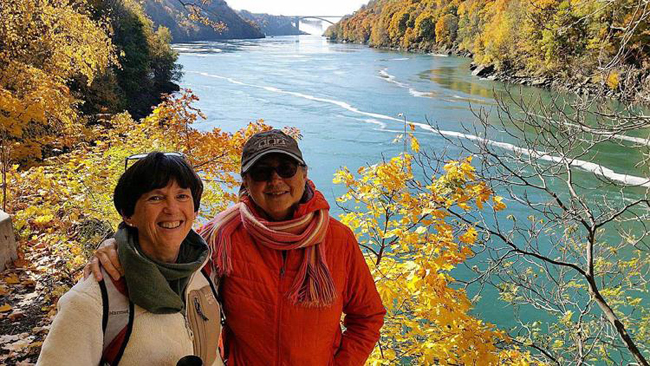
Nancy Smith and Mary McCutcheon from the Western New York Land Conservancy pose for a photo in the Niagara Gorge. The Western New York Land Conservancy was awarded nearly $1 million for its “Restore the Gorge” project from the Niagara River Greenway Ecological Standing Committee. Credit: Tom Smith / Niagara Gazette.
— Filed by: Staff reporter for Niagara Gazette
Niagara Falls, NY, May 28, 2019 - Work is progressing to the second phase for on-the-ground ecological restoration work to Restore the Gorge in Niagara Falls.
On Tuesday, state officials announced nearly $950,000 in additional Greenway Ecological Fund grants to further efforts to combat invasive plant species and cultivate native plants. The project complements the state’s $70 million revitalization of Niagara Falls State Park and other strategic state investments to strengthen the tourism industry in downtown Niagara Falls, according to a release from Gov. Andrew Cuomo’s office.
"Niagara Falls is a gem and one of our great tourist attractions in upstate New York and around the world," said Lt. Gov. Kathy Hochul, who made Tuesday's announcement. "The Niagara River Gorge is one of the most important natural places in the world, and this additional funding will further our efforts to combat invasive species to restore and enhance the natural habitat. This investment complements our support to revitalize the Niagara Falls State Park, various hotel developments, and other projects to increase tourism and grow the economy of Western New York."
The Niagara Gorge was once one of the most botanically diverse places in North America and restoring the native flora will benefit wildlife such as migratory birds, which in turn supports the growth of the Niagara Greenway as an eco-tourism destination. Hochul gave several native red oak saplings to children following the announcement to mark the occasion.
'Restore the Gorge' is an effort to transform the ecological health of the Niagara River Gorge and rim by controlling invasive species and planting native trees, shrubs, grasses and flowers in the Niagara Gorge from the Niagara Gorge Discovery Center to Devil's Hole State Park. The Western New York Land Conservancy has been leading the initial phase of efforts to restore and enhance the natural habitat on 37 acres of land along the gorge with an initial $1 million in funding from the New York Power Authority via the Niagara Greenway and the Ecological Standing Committee.
With the addition of $1 million from Empire State Development in January 2017, as well as funds from New York Sea Grant and the Verizon Media Community Benefit Fund for Niagara County (formerly the Oath Community Fund), the Land Conservancy has been able to expand the initial phase of removing invasive species, and is working to restore an additional 48 acres within the gorge and along the rim in Whirlpool State Park. This second installment of Greenway Ecological Fund grants will further advance the project. Land in the project area is owned by the New York Power Authority and by the New York State Office of Parks, Recreation, and Historic Preservation.
"Working in the Niagara Gorge is an extraordinary opportunity to give back to nature in a place that builds community, while showcasing the value of native plants on the world stage,” Land Conservancy Executive Director Nancy Smith said. “Our efforts will increase biodiversity, provide habitat for butterflies and songbirds, and purify our fresh water. This project will reconnect people with nature and enhance the economic vibrancy of Niagara Falls."
Congressman Brian Higgins said the Western New York Land Conservancy is leading the way on identifying, preserving and enhancing unique pieces of Western New York's natural landscape.
“The Niagara Gorge is a destination like none other,” Higgins said. “This additional investment of Niagara Greenway money, made possible through the relicensing settlement with the New York Power Authority, will build on New York state's significant investment in Niagara Falls."
Falls Mayor Paul Dyster called the effort “transformative” for the city.
“Thanks to the efforts of the Western New York Land Conservancy, the Niagara Gorge will continue to enrich the visitor experience as one of the most biologically diverse ecosystems for many years to come,“ he said.
As one of the most biologically diverse places on the Great Lakes, the Niagara Gorge is home to unique ecological communities, including many rare plants, and is part of a globally significant Important Bird Area. The lower Niagara River rapids are important spawning grounds for freshwater fish including threatened lake sturgeon.
More Info: New York Sea Grant
New York Sea Grant (NYSG), a cooperative program of Cornell University
and the State University of New York (SUNY), is one of 33 university-based
programs under the National Oceanic and Atmospheric Administration’s
National Sea Grant College Program.
Since 1971, NYSG has represented a statewide network of integrated
research, education and extension services promoting coastal community
economic vitality, environmental sustainability and citizen awareness
and understanding about the State’s marine and Great Lakes resources.
Through NYSG’s efforts, the combined talents of university scientists
and extension specialists help develop and transfer science-based
information to many coastal user groups—businesses and industries,
federal, state and local government decision-makers and agency managers,
educators, the media and the interested public.
The program maintains Great Lakes offices at Cornell University, SUNY
Buffalo, SUNY Oswego and the Wayne County Cooperative Extension office
in Newark. In the State's marine waters, NYSG has offices at Stony Brook
University in Long Island, Brooklyn College and Cornell Cooperative
Extension in NYC and Kingston in the Hudson Valley.
For updates on Sea Grant activities: www.nyseagrant.org has RSS, Facebook, Twitter, and YouTube links. NYSG offers a free e-list sign up via www.nyseagrant.org/nycoastlines for its flagship publication, NY Coastlines/Currents, which is published quarterly. Our program also produces an occasional e-newsletter,"NOAA Sea Grant's Social Media Review," via its blog, www.nyseagrant.org/blog.